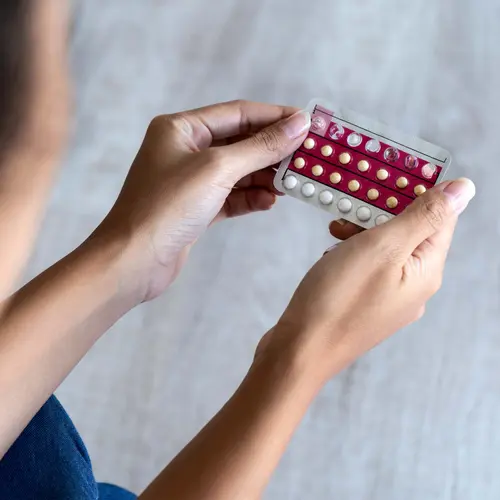Nexplanon (formerly Implanon) is the brand name of a toothpick-sized rod that your doctor puts under the skin on the inner part of your upper arm. You’ll hear it called the implant.
You’ll get a shot to numb the area. The doctor will use a special needle to insert the rod. They’ll put a bandage over the site, which might be sore for a few days. Afterward, you should be able to feel the implant just under your skin.
The implant releases enough etonogestrel, a manmade form of the hormone progesterone, on a daily basis to keep you from getting pregnant. The medication in one implant should work for 3 years without problems. You can get it removed at any time.
What’s the Pill?
It’s a regular dose of synthetic hormones (estrogen and progestin) that you take by mouth every day to prevent pregnancy. A less common, and less effective, form of the pill, sometimes called the “mini-pill,” uses only progestin.
The implant is more like the mini-pill in that it uses only artificial progesterone, without estrogen, to prevent pregnancy.
How Do They Work?
Both the pill and the implant slow your pituitary gland, which stops your ovaries from releasing eggs. The drugs also change the surface of your uterus and cervix so it’s harder for sperm to make their way to the egg.
How Fast Do They Work?
It takes about 7 days for the pill to take full effect. So use extra protection, like condoms, for those first 7 days.
The implant starts working almost immediately if your doctor implants it in the first 5 days of your period. If you and your doctor decide to start Nexplanon in the middle of your cycle, you’ll need to use condoms for around a week to be sure you’re protected.
How Well Do They Work?
When used exactly as directed, the pill is very effective. What does that mean?
For the pill, it means you take it at the same time every day. This is sometimes called perfect use. If you do that, you have less than 1 in 100 chance of getting pregnant in the next year.
But if you miss a day or two or take the pill at different times of day, the pill becomes about 91% effective.
Once your doctor places the rod in your arm, you’re done. This low-maintenance birth control method provides a less than 1 in 100 chance of getting pregnant in the next year.
Do They Have Other Benefits?
Besides preventing pregnancy, both the pill and the implant can also lead to:
- Lighter periods: Less blood and cramping (sometimes no period at all)
- Less chance of anemia: Lighter periods mean less blood loss and more red blood cells
There’s some proof that the pill helps prevent certain cancers, ovarian cysts, and other illnesses. It also typically keeps your period more regular so you start promptly about every 28 days. And it could help clear up your skin. The hormones seem to help prevent acne, though it could take a few months before you see the difference.
Some studies show the implant might help ease endometriosis pain, but scientists need to study this more to be sure.
How Do I Get Them?
Your doctor or – in some states – pharmacist can prescribe birth control pills. A version of the norgestrel-only minipill is available over the counter.
You get the implant from your doctor.
How Much Do They Cost?
Most insurance covers either method. With insurance, you’ll probably pay a monthly copay between $0 and $50 for the pill. If your insurance covers the implant, you'll pay a copay for the visit to have it implanted or removed.
There are options if you don’t have insurance. Family planning clinics will usually provide the pill, Nexplanon, or some other form of safe birth control at little or no cost to you.
Are There Side Effects?
Most birth control medications have side effects, though they’re different for each woman.
Both the pill and the rod could cause:
- Headaches
- Mood changes including depression
- Breast tenderness
- Upset stomach
- Changes in your period
- No period
The pill also could cause rare but more serious problems like blood clots, stroke, and heart attack. These are more common in smokers and women over 35.
Nexplanon also seems to cause acne and hair loss in some women. Talk to your doctor if you notice these side effects.
Are They Safe?
It’s safe, but the pill might not be the best choice for every woman. Talk to your doctor if you have:
- Heart disease
- Blood that clots too easily or genes that put you at risk for blood clots
- Migraine headaches with aura, numbness, or other problems
- High blood pressure not controlled by medication
- Problems moving around due to surgery or some other issue
Nexplanon is also safe for most women, but it could cause problems if you have:
- Breast cancer (or have had it in the past)
- Vaginal bleeding for no obvious reason
- Some form of liver disease
Talk to your doctor if you notice any of these or you think you’re at risk.
In rare cases, the rod can move. Tell your doctor if you can no longer feel it just under your skin.
How Do You Safely Stop Using Them?
You may want to stop your birth control. It’s easy to stop the pill. Just don’t take it anymore. Your body should go back to its natural cycle within a few days. You can get pregnant almost immediately after you stop, so start using another birth control method right away if you don’t want that.
You’ll need to see your doctor to remove the implant. You’ll be able to get pregnant right away, so plan on switching to another birth control method about a week before you have the implant removed if you don’t want to conceive.

